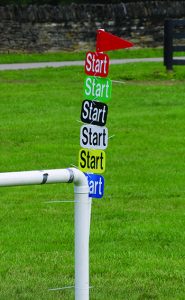
 If you like a little splash of adventure in your riding, then eventing might be the right sport for you! Eventing involves three phases: dressage, cross-country and stadium jumping. Dressage tests suppleness and precision in a defined pattern scored by a judge; cross-country requires jumping over solid obstacles in the open, including ditches, banks and water; and stadium jumping involves not knocking down any rails over arena jumps.
If you like a little splash of adventure in your riding, then eventing might be the right sport for you! Eventing involves three phases: dressage, cross-country and stadium jumping. Dressage tests suppleness and precision in a defined pattern scored by a judge; cross-country requires jumping over solid obstacles in the open, including ditches, banks and water; and stadium jumping involves not knocking down any rails over arena jumps.
You can find unrecognized (schooling) shows through your local area’s eventing association. Beginner-friendly events might be called “mini-trials” or one-day events.
The Right Horse
You don’t need to own a horse to event, but you will need to practice regularly with a leased horse or lesson mount that you will be competing on.
Your horse should be calm and sane above all else. Since cross-country requires galloping out in the open, very hot or nervous horses can be downright dangerous, especially for kids.
Your pony should be able to listen well in any situation, and be reliable over jumps. There are enough technical challenges involved in eventing that you don’t need the frustration of a dirty stopper!
Any size, color or breed will do, although gaited horses aren’t permitted in dressage. The great thing about eventing is the wide variety of horses and ponies of every shape, size and color competing.
Flatwork Finesse

(Photo courtesy Elizabeth Moyer)
Dressage basics at the lower levels are similar to flatwork in any other discipline. You want your horse to be in tune with your cues, not rushing or needing constant kicking. He should show bend through his body around 20-meter circles, which are up to you to ride as round as possible.
In eventing dressage, accuracy counts for a lot! You definitely don’t need the world’s fanciest mover as long as your horse listens to you and moves forward and you ride the test accurately.
It’s better not to over-practice your test at home, because your pony will start to anticipate the transitions and break gait too early. Still, it’s best to ride in a dressage arena with letters marked so you get used to the reference points.
School movements like halting on the centerline at various spots and circling in different locations. Work on walk to trot, trot to walk, and trot to canter transitions at different letters (up transitions to canter will always be on a curve). Aim to get your new gait exactly at a letter.
Jumping Required
The lowest level of eventing recognized by the United States Eventing Association (USEA) is Beginner Novice, where jumps are 2’7″. But you’ll probably want to start smaller than that with Intro or Starter divisions at 2′.

(Photo courtesy Leslie Potter.)
It’s easy enough to get stadium jumping practice in a ring. You’ll need to get your horse familiar with colored poles and jump fillers like gates and flowers. Most approaches are direct on straight lines or off a turn. Occasionally you might see a two-stride combination, but nothing more complex than that at the lower levels. There are 8 to 10 jumps in a course.
Before you can jump cross-country, your horse needs to be comfortable and obedient riding out in the open. Practice this first before adding jumps to the mix. You’ll want a few good cross-country schooling sessions before your first event, which will have 12 to 18 jumps on course, possibly including a small ditch or bank and splashing through a water obstacle.
Go with your trainer and at least one experienced horse so you’ll have a lead into the water or over any obstacles your horse finds scary. You want to make it a positive, confidence-boosting experience for both of you. Don’t overdo your first schooling, but end on a high note when your horse is comfortably cantering at least four jumps in a row and can leave the group calmly without balking.
Put Your Skills to the Test

(Photo courtesy Elizabeth Moyer.)
When you’re ready to head to the show, make sure to look up whether jackets and braiding are required or encouraged. Some schooling shows are very casual and you can ride in a polo shirt with an unbraided mane. Others are held under the same rules as recognized competitions.
Familiarize yourself with the USEA rulebook—it can be found online at www.useventing.com. Three to four stops on cross-country generally constitutes elimination, but in stadium jumping you’ll be eliminated for a second refusal except in schooling shows specifically run as “no elimination” format.
Be sure you know your ride times and plan ahead so you can be tacked up and warm up your horse for each phase. It’s always best to have your trainer coach you for each phase when you first get started eventing. Best of all is to compete with other friends from the barn so you can share in the fun together and make lifelong memories.
Once you ride through the finish flags on cross-country after a positive round, there will be no stopping you. Eventers can’t wait to get back out and do it all again!
This article originally appeared in the July/August 2018 issue of Young Rider magazine. Click here to subscribe!





